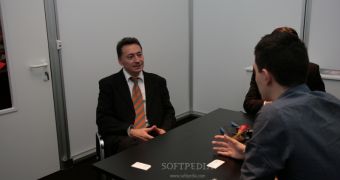Back at CeBIT 2010, in Hanover, Germany, we had the chance to talk with Christian Morales, vice president and general manager for Intel EMEA. We had a very interesting conversation about Intel's multi-core strategy, but also about the outfit's growing presence in the smartphone market. As you'll see in the interview, users should expect Intel to be inside their smartphones by the end of this year, while for 2011, the company hopes to be inside a wider number of smartphone devices.
Can you briefly tell us what we can expect from Intel in 2010?
Back in 2009 we accelerated our investments in new technologies, such as 32nm, in new architectures, which we just announced at the beginning of this year, the new Core i3, Core i5 and Core i7. Basically we are entering 2010 with a very strong product portfolio, new architectures and new technologies.
Intel is widely known as a world leading manufacturer of computer processors, but the company is clearly expanding its horizons. Which are the segments that we should expect Intel to debut?
Currently we are in desktops, on notebooks, on servers, but we are going on two adjacent markets. One is that of consumer electronics, where we can bring the Internet experience to your TV screen, while the other is that of smartphones, where we can bring an Internet experience into your smartphone. This is essentially the value proposition and the key difference we have with the Intel architecture.
Processors continue to increase their core count as technology advances. When can we expect 6-core or 12-core processors running mainstream computers, or home devices?
Right now we have desktop solutions on two cores, on four cores and on six-cores and eight cores for servers. Just recently we showed a wafer with 48-cores, which can compute a huge amount of data. Hopefully, in several years from now, we will be able to shrink this into a much smaller integrated technology, to bring this level of performance to the users, in laptops, in desktops and in workstations.
Most mainstream consumers aren't aware of the performance changes of multi-core technology. What can you tell us about the performance advantages of multi-core processors for mainstream consumers? Back in 2006 when we launched our dual-core technology, we wanted to address two key issues. One was that the increasing of Gigahertz lead to an increase in power consumption. This meant that we had to make designs that would be much more energy-efficient, but will keep on bringing more performance to the users. It's a matter of bringing both performance but also energy-efficiency. If we are talking about a laptop, you'd want to have longer battery life, which is also the case with smartphones. Basically, the dual-, quad-, eight-core strategy allows you to have more performance, but also be more energy-efficient.
For example, if you have a server architecture that supports the Internet industry, we have, in the last four years, been able to increase the level of efficiency by 90%. With 9 servers you had a certain performance, now you can replace them with one server. You'll get the same amount of performance, but 90% less space and 90% power consumption. We see the same improvement taking place in Xeon, next year and we think this will continue in the future. You'll see more and more performance and more and more energy-efficiency. We're not talking about 10-15% gains, we are talking about several X amount of improvements.
Your recent collaboration with Nokia has generated a considerable amount of media attention. You partnered with one of the biggest players in the smartphone market, but how is Intel going to revolutionize this market? The users want to have a great experience when they access rich content on the Internet, they obviously want a great phone and voice quality, but there are also the ones that want a great battery life. We are doing great on performance, we still have work to be done on energy-efficiency. We have a product, codenamed Moorestown, that was recognized in a smartphone, in Las Vegas, at CES in January, as the best smartphone of the event. This is from LG and is a great design based on Moorestown. There also the acquisition of WindRiver and the announcement that we are going to merge our Linux software platform, which is called Moblin, with the Maemo platform from Nokia.
This is going to bring the most stable and efficient Linux platform that is available in the world right now and we are hoping to get huge amount of applications written around it, very strong industry support and have the industry embrace this platform. Hopefully, in the next couple of years, we are going to see a breakthrough in smartphones from a combination of our great innovation technology and this great software platform that is called MeeGo, by the way.
When can we expect Intel-powered smartphones being generally available?
Hopefully we are going to see the one presented at CES, this year, in production by the end of the year. The next-generation product that is called Medfield is going to be introduced in 2011 and hopefully we are going see products right after that, which will be equipping the next-generation smartphones. We are hoping you'll have a great experience with that so that you'll want to purchase one.

 14 DAY TRIAL //
14 DAY TRIAL //